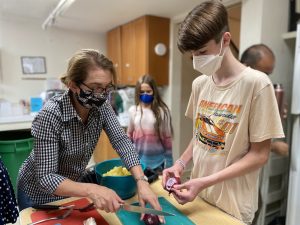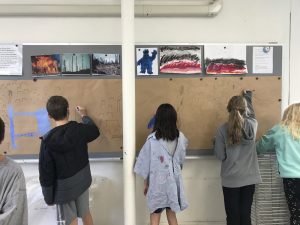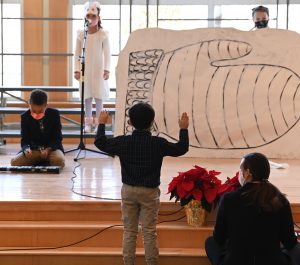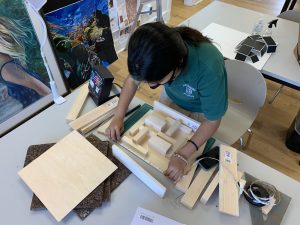Teaching Creativity in the Brandywine Valley
Rising to the challenges of the 21st century

In 1961, President John F. Kennedy challenged the nation to land a person on the moon by the end of the decade. By mid-1969, Neil Armstrong took a “giant leap for mankind.”
At the end of 2019, when the deadly COVID-19 virus emerged in Wuhan, China, scientists worldwide began searching for a vaccine. Less than a year later, vaccines began entering arms. Until then, it had taken a minimum of four years to develop a vaccine for such a serious disease.
These tasks demanded enormous creativity, problem-solving, inventiveness, imagination, persistence, motivation, risk-taking and teamwork. As we consider current and future challenges, we wonder whether and how our schools develop these attributes in today’s students, who will be tomorrow’s leaders. Preparation at this level is a far cry from the basic 3Rs.
How are local schools teaching these essential skills?
Is Creativity Teachable?
The answer, almost universally among the independent schools in County Lines country, is yes, creativity is teachable, at least to some extent. Paulo Machado, Visual Arts teacher at Wilmington Friends Middle School says creativity is taught by “helping students imagine multiple solutions to a problem, to brainstorm, to not fall in love with the first idea that comes to you, to ask ‘what if’ questions, and to be open to failure and criticism.”
Machado believes creativity is the ability “to bring something new into the world. Many people are imaginative, but they may not be creative. Creativity implies an idea, a medium and an art. To create is to make our thinking visible.”

Heather Brooks, teaching STEM (science, technology, engineering, math) at The Tatnall School, also believes creativity is teachable. But it must be controlled. Kids need “to wonder about things.” The teacher must be organized and need to have teaching methodologies. Teachers need to “allow messiness to happen,” while retaining full control of the situation. Students should be allowed to “investigate on their own terms, even if they’re going to hit a dead end. To learn, they must be allowed to fail first.”
Teaching art at West Chester Friends School, Catharine Maloney observes that students “come to school with creativity built in. They aren’t afraid to mess up or to try new things … As students grow, they often get self-conscious about their work. My job is to keep that engagement and creativity going.”
Angela DiMaria, Assistant Head of School at Media-Providence Friends School, agrees but says that creativity looks different, depending on how each student approaches it. Finding creativity in each student is part of the challenge. A kid must be “encouraged to be brave, encouraged to take risks, to ask questions, to fail … That’s how we learn.”
In the Classroom

At Wilmington Friends School, Katie Martinenza, Performing Arts teacher in the Lower School, concurs with a resounding yes to creativity’s teachability. “Creativity is a skill that’s nurtured through experiences that allow us to use knowledge in new and innovative ways.” In fact, she believes that “non-creativity is a learned behavior.” She continues, “Look at children and the way they play. Young children use their imaginations to manipulate objects and come up with new ideas for how they can work.”
To inspire creativity, Martinenza encourages students to try different approaches. In music, students start by repeating a musical phrase, and are led to improvisation activities, creating their own, different and varied replies to melodic and rhythmic questions. They are encouraged to develop their own chants and songs. To build confidence, she also lets “creativity shine through” by allowing students to have a voice in decision-making about choreography, costuming and instrumentation during self-accompanied songs.
A slightly different view is voiced by David Sigel, Visual Arts teacher at The Episcopal Academy. His thought is that strengthening creativity requires “reconnection,” which in turn requires practice, focus and time. Creativity demands that we “push the envelope” and “step outside of our comfort zone.” He motivates students toward self-discovery.
Sigel is working in 2D (two dimensional) design, guiding his students in arts like animation, graphic novel, observational oil painting and collage. He’s especially proud of one student who “pushed her boundaries” making drawings and films, another making sketches inspired by his father, yet another who’s gone on become a landscape architect. Before they studied under him, these students had no inkling of their creative side.
Devising New Ways of Teaching
Media-Providence’s Angela DiMaria, who taught fifth grade, describes an exercise she used in math class. She would pose the problem, then give the answer, and ask for three different ways to come to the answer. The teaching point was that it’s not primarily about solving the problem quickly. Rather, it’s about solving the problem creatively.
She also describes a problem in science class, involving aquaponics. The students must figure out the cause and effects of a multiple-factor system. “The interconnectedness of all the different disciplines is very important to us.”’

The Haverford School, in fact, focuses on the interdisciplinary nature of real-world problems. In its Ford Focus Days, a seven-day program that’s been successfully inserted in the middle school curriculum by three teachers, the “need to think across disciplines” stands out. Students applied their problem-solving skills to “the earth’s problems” and the United Nation’s Sustainable Development Goals. The practical experience promotes passion, perseverance, curiosity, intellectual humility and character: all aspects of useful creativity.
Cheryl Joloza, who teaches science to the fifth grade at The Haverford School, describes her class’s goal as “thinking differently.” She seeks to induce “out-of-the-box” thinkers, in part by stressing that there’s “no one right way to solve a problem.” She wants students that are willing to take risks and asserts that “failure is good learning.”
Reinventing School
My role is to “create the conditions where creativity can emerge,” says Dan Hickey, the Head of the Upland Country Day School. He speaks of the music, visual arts and drama programs. The school has an “idea center” where students learn “important things.” Unshackled by the constraints imposed in a public school, the teachers are given autonomy and have responded with a “passionate” and “joyful” style. An English teacher himself, Hickey emphasizes risk-taking: the kids “can’t be afraid to fail.”
Brian Fahey, Head of West Chester Friends School, says, “I would measure success by observing students …. Are they comfortable taking a risk? Do they feel the need to copy others, or to ‘color between the lines’? Do they find freedom and joy in the creative process? What do they have to say about their own work?”

“Just trying something new, whether that new result is acceptable or not, is success,” says Brian Manelski, English teacher & Theater director at Archmere Academy. “When students feel the freedom to write or say whatever comes to their mind, that’s the success. I tell students that they will fail 90% of the time that they explore the creative world. But persistence and willingness to build off failures means creative ideas later on.”
Risk-taking is rewarded. Messiness welcome. Failure invited. Imagination encouraged. Passionately, joyfully, our independent schools are blazing a new path to foster creativity in this generation of students.
